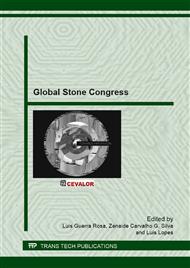p.57
p.65
p.72
p.82
p.90
p.98
p.106
p.115
p.124
Electro-Contact Discharge Dressing of Cut-Off Grinding Disks for Natural Stone Machining
Abstract:
In cut-off grinding of natural stone the tool performance and stability mainly depends on the self-sharpening behaviour of the cutting segments. Therefore, it is essential to adjust the bonding composition and the process parameters according to the specific separation mechanisms of the work piece material. Different tool wear mechanisms resulting from the different natural stone categories currently avoid the continuous use of one bonding specification. To overcome this limitation an electro-contact discharge dressing (ECDD) process was implemented in the cut-off grinding process. In this way, the backspacing of the bonding can be controlled in-process. The research presented in this paper focuses on the introduction of this technology in the field of stone machining. The demands for applying ECDD in the environment of a stone saw as well as the main influences and interdependencies of ECDD onto the segment topography are discussed.
Info:
Periodical:
Pages:
90-97
Citation:
Online since:
April 2013
Authors:
Price:
Сopyright:
© 2013 Trans Tech Publications Ltd. All Rights Reserved
Share:
Citation:


